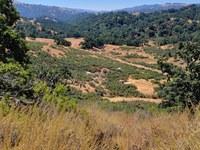The 2024 Field School is being held at the Blue Oaks Ranch Reserve (BORR). Information on camp living, weather, basic expectations, safety, and transportation is below.

BORR is a 3,280-acre Biological Field Station and Ecological Reserve, one of the 40+ units of the University of California Natural Reserve System (UCNRS), and is operated jointly by the Office of the Vice-Chancellor for Research and the UCNRS. The Reserve provides a wealth of research and teaching opportunities in a wide range of important Californian habitats. BORR is a wildland environment located some distance from urban facilities; precautions for potential hazards will be taken, similar to those for a back-country hike. There are downed logs, unstable rocks, steep slopes, cliffs, ground squirrel holes, steep and narrow roads, and many other potential hazards.
The weather is generally sunny in the summer, with average temperatures in August ranging from a daily low of 16.6°C (62.5°F) to an average daily high of 25.5°C (78°F). However, highs can be over 90°F but rarely exceed 95°F. It is dry with little humidity, and it can get quite warm when in direct sunlight.. Rain is not common during the summer, but occasionally, a shower or thundershower will go through the valley. Although usually warm, the area can be cool in the evenings, especially in September.
The physical demands beyond summer heat are that some hiking (with hills) will be required, and excavation will entail low-intensity physical labor over a 7- to 8-hour day. Students will not be asked to do any more physical activity that could be asked of an average person. Heat conditions will be taken into consideration in conjunction with physical activity, and plans are in place to ensure shade.
For more information, see https://blueoakranch.ucnrs.org/facts-at-a-glance/ for more information about the reserve.
